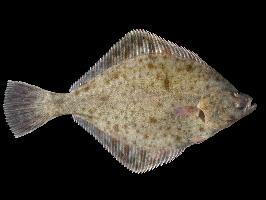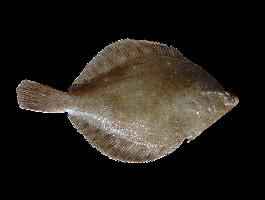
Poids et mesures
| Longueur | de 50 à 60 cm |
|---|
Données biologiques
| Durée de vie | de 8 à 9 ans |
|---|
Description de l'animal
The European flounder, scientifically known as Platichthys flesus, is a fascinating and versatile species of flatfish predominantly found in the waters surrounding Europe. This species exhibits a remarkable adaptability to different aquatic environments, thriving in both freshwater and marine ecosystems. Its geographical range extends from the coastal waters of the North Atlantic and the Baltic Sea to as far as the Mediterranean and the Black Sea. The European flounder has played a significant role in the cultural and economic life of coastal communities, being a popular target for both commercial fisheries and recreational anglers.Physically, the European flounder is distinguished by its oval-shaped, laterally compressed body, which is perfectly adapted to life on the seabed. The fish's coloration is particularly noteworthy; its upper side is dark with varying shades of brown, green, or gray, camouflaging it against the seabed, while the underside remains a stark white. This coloration is not only a defensive mechanism against predators but also aids in ambushing prey. The species can further camouflage itself by partially burying in the substrate. The European flounder's eyes are located on the right side of its body, which is a common trait among flatfish, allowing it to have a panoramic view of its surroundings while lying flat on the seabed.
One of the most fascinating aspects of the European flounder is its lifecycle and reproductive behavior. Spawning occurs between the months of March and June, depending on the water temperature and geographical location. Females can lay up to 2 million eggs, which float freely in the water column until hatching. The larvae are initially symmetrical, with one eye on each side of their head. However, as they mature, they undergo a remarkable metamorphosis, during which one eye migrates to the other side of the body, resulting in their distinctive flat appearance.
The diet of the European flounder consists mainly of small fish, crustaceans, and invertebrates, which they hunt using a strategy of ambush predation. Their ability to blend into their surroundings makes them formidable predators despite their slow movement.
Despite their abundance, the European flounder faces threats from habitat destruction, pollution, and overfishing in some areas. Conservation efforts are crucial to ensure the sustainability of their populations and to protect the diverse ecosystems they inhabit.
In summary, the European flounder is a species of remarkable adaptability and resilience, embodying the intricate balance of marine ecosystems. Its unique physical characteristics, intriguing lifecycle, and the role it plays in the aquatic food web make it a subject of interest not only for the scientific community but also for those involved in conservation and fisheries management.
Animaux similaires
Nouvelles photos d'animaux
Top 10 des animaux
- Dolphin gull (Leucophaeus scoresbii)
- Diana monkey (Cercopithecus diana)
- Moustached guenon (Cercopithecus cephus)
- Galápagos tortoise (Geochelone nigra complex)
- Russian tortoise (Testudo horsfieldii)
- Japanese macaque (Macaca fuscata)
- Stone loach (Barbatula barbatula)
- Greek tortoise (Testudo graeca)
- Common flying dragon (Draco volans)
- Colossal squid (Mesonychoteuthis hamiltoni)

